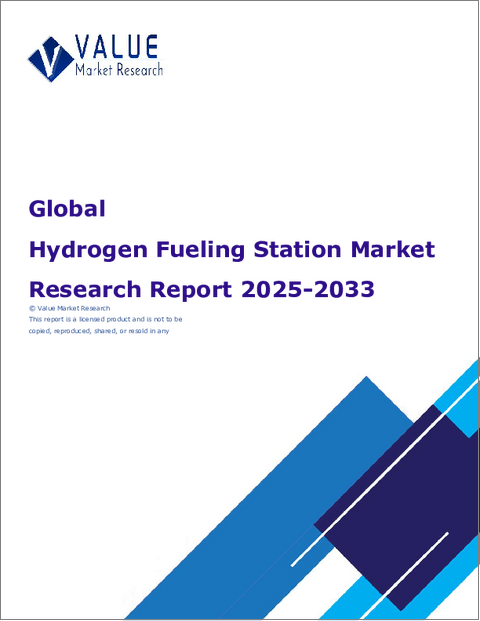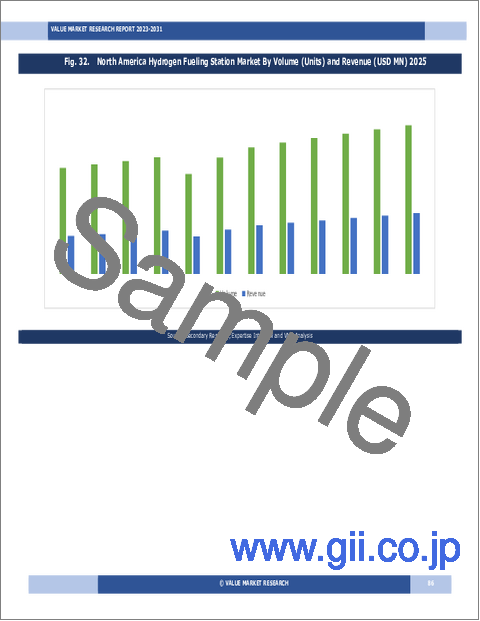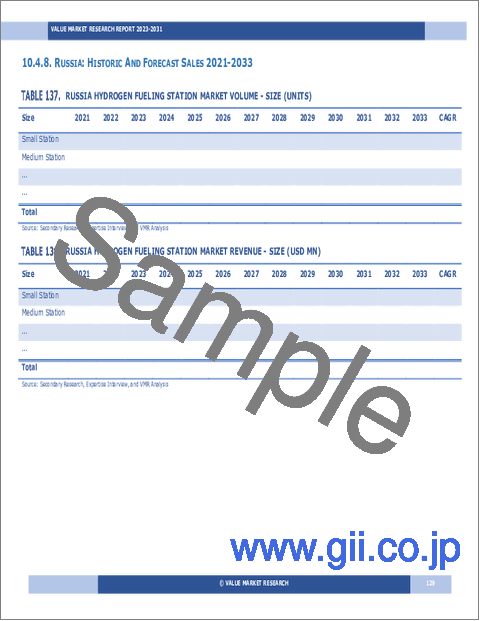|
|
市場調査レポート
商品コード
1761996
水素ステーションの世界市場調査レポート:産業分析、規模、シェア、成長、動向、2025年から2033年までの予測Global Hydrogen Fueling Station Market Research Report- Industry Analysis, Size, Share, Growth, Trends and Forecast 2025 to 2033 |
||||||
カスタマイズ可能
|
|||||||
| 水素ステーションの世界市場調査レポート:産業分析、規模、シェア、成長、動向、2025年から2033年までの予測 |
|
出版日: 2025年07月01日
発行: Value Market Research
ページ情報: 英文 260 Pages
納期: 即日から翌営業日
|
全表示
- 概要
- 図表
- 目次
水素ステーションの世界市場規模は、2024年の5億1,614万米ドルから2033年には36億1,912万米ドルに成長し、2026年から2033年の予測期間中に24.16%の堅調な年間平均成長率(CAGR)を示すと予測されます。
水素ステーション市場は、クリーンで持続可能な輸送ソリューションに対する需要の高まりに牽引され、大きな成長を遂げています。自動車産業が電動化と温室効果ガス排出削減に向けてシフトする中、水素燃料電池車(FCV)用の実行可能なインフラ・ソリューションとして水素ステーションが台頭しています。これらのステーションは、テールパイプ排出がゼロで、バッテリー式電気自動車よりも航続距離が長い水素自動車の普及をサポートするために必要な燃料補給インフラを提供します。水素インフラと燃料電池技術を促進するための政府のイニシアティブやインセンティブが台頭していることも、水素ステーション需要をさらに押し上げています。
技術の進歩も水素ステーション市場の将来を形成しています。水素の製造、貯蔵、供給技術における革新は、より効率的で費用対効果の高い燃料ステーションの開発を可能にしています。さらに、太陽光や風力などの再生可能エネルギーを水素製造に統合することで、水素サプライチェーンにおける持続可能性の向上と二酸化炭素排出量削減の機会がもたらされています。市場が進化を続ける中、ステーションの性能向上と再生可能エネルギー源との統合のための技術活用能力は、市場シェア獲得を目指す利害関係者にとって極めて重要です。
さらに、持続可能性と環境責任を重視する消費者の高まりが、水素ステーション市場に影響を与えています。クリーンなエネルギー源としての水素の台頭は、メーカーやエネルギー・プロバイダーに、性能要件を満たしながら環境への影響を最小限に抑える革新的なソリューションの探求を促しています。環境問題への意識が高まり続ける中、水素ステーション市場は成長する好機に恵まれており、持続可能な交通インフラの進化に対応し、革新する利害関係者に大きな機会を提供しています。
当レポートは、様々な産業や市場に関する包括的かつ実用的な洞察をお客様に提供できるよう、綿密に作成されています。各レポートは、市場情勢を完全に理解するために、いくつかの重要な要素を含んでいます:
市場概要:定義、分類、業界の現状など、市場に関する詳細なイントロダクション。
市場力学:市場成長に影響を与える主な促進要因・抑制要因・機会・課題を詳細に分析します。このセクションでは、技術の進歩、規制の変更、新たな動向などの要因を検証します。
セグメンテーション分析:製品タイプ、用途、エンドユーザー、地域などの基準に基づき、市場を明確なセグメントに内訳。この分析により、各セグメントの業績と将来性を明らかにします。
競合情勢:市場シェア、製品ポートフォリオ、戦略的イニシアティブ、財務実績など、主要市場企業の包括的評価。主要企業が採用する競合力学と主要戦略に関する考察を提供します。
市場予測:過去のデータと現在の市場状況に基づき、一定期間における市場規模と成長動向を予測します。これには、定量的分析と将来の市場軌跡を示すグラフ表示が含まれます。
地域分析:地域ごとの市場パフォーマンスを評価し、主要市場や地域動向を明らかにします。地域の市場力学とビジネスチャンスを理解するのに役立ちます。
新たな動向と機会:現在の市場動向と新たな市場動向、技術革新、潜在的な投資対象分野を特定します。将来の市場開拓と成長見通しに関する洞察を提供します。
目次
第1章 序文
第2章 エグゼクティブサマリー
- 市場のハイライト
- 世界市場スナップショット
第3章 水素ステーション産業分析
- イントロダクション:市場力学
- 市場促進要因
- 市場抑制要因
- 市場機会
- 業界動向
- ポーターのファイブフォース分析
- 市場の魅力分析
第4章 バリューチェーン分析
- バリューチェーン分析
- 原材料分析
- 原材料リスト
- 原材料メーカーリスト
- 主要原材料の価格動向
- 潜在的バイヤーリスト
- マーケティングチャネル
- ダイレクトマーケティング
- インダイレクトマーケティング
- マーケティングチャネル発展動向
第5章 世界の水素ステーション市場分析:規模別
- 概要規模
- 過去および予測データ分析
- 小規模ステーション
- 中型ステーション
- 大型ステーション
第6章 水素ステーションの世界市場分析:タイプ別
- 概要タイプ
- 過去および予測データ分析タイプ
- オンサイト
- オフサイト
第7章 世界の水素ステーション市場分析:モビリティ別
- 概要モビリティ
- 過去および予測データ分析モビリティ
- 固定水素ステーション
- 移動式水素ステーション
第8章 水素ステーションの世界市場分析:圧力別
- 概要圧力
- 過去および予測データ分析圧力
- 低圧
- 高圧
第9章 水素ステーションの世界市場分析:最終用途別
- 概要最終用途
- 過去および予測データ分析最終用途
- 海洋
- 鉄道
- 商用車
- 航空
第10章 水素ステーション世界市場分析:地域別
- 地域別展望
- イントロダクション
- 北米の売上分析
- 概要、実績と予測
- 北米:セグメント別
- 北米国別
- 米国
- カナダ
- メキシコ
- 欧州売上分析
- 概要、実績と予測
- 欧州セグメント別
- 欧州国別
- 英国
- フランス
- ドイツ
- イタリア
- ロシア
- その他の欧州
- アジア太平洋売上分析
- 概要、実績と予測
- アジア太平洋セグメント別
- アジア太平洋国別
- 中国
- インド
- 日本
- 韓国
- オーストラリア
- 東南アジア
- その他のアジア太平洋
- ラテンアメリカ売上分析
- 概要、実績と予測
- ラテンアメリカセグメント別
- ラテンアメリカ国別
- ブラジル
- アルゼンチン
- ペルー
- チリ
- その他のラテンアメリカ
- 中東・アフリカ売上分析
- 概要、実績と予測
- 中東・アフリカセグメント別
- 中東・アフリカ国別一覧
- サウジアラビア
- アラブ首長国連邦
- イスラエル
- 南アフリカ
- その他の中東・アフリカ
第11章 水素ステーション企業の競合情勢
- 水素ステーション市場競合
- パートナーシップ/提携/合意
- 合併・買収
- 新製品発売
- その他の開発
第12章 企業プロファイル
- 上位企業の市場シェア分析
- 市場集中度
- Air Liquide
- China Petroleum & Chemical Corporation
- H2 Energy Solutions Ltd.
- Cummins Inc.
- Linde Plc
- Air Products And Chemicals Inc.
- FuelCell Energy Inc.
- ITM Power PLC
- Ballard Power Systems Inc.
- Nel ASA
- TotalEnergies SE
LIST OF TABLES
- Market Snapshot
- Drivers: Impact Analysis
- Restraints: Impact Analysis
- List of Raw Material
- List of Raw Material Manufactures
- Analysis Size (Units and USD MN)
- Small Station Market Sales By Geography (Units and USD MN)
- Medium Station Market Sales By Geography (Units and USD MN)
- Large Station Market Sales By Geography (Units and USD MN)
- Analysis Type (Units and USD MN)
- On Site Market Sales By Geography (Units and USD MN)
- Off Site Market Sales By Geography (Units and USD MN)
- Analysis Mobility (Units and USD MN)
- Fixed Hydrogen Station Market Sales By Geography (Units and USD MN)
- Mobile Hydrogen Station Market Sales By Geography (Units and USD MN)
- Analysis Pressure (Units and USD MN)
- Low Pressure Market Sales By Geography (Units and USD MN)
- High Pressure Market Sales By Geography (Units and USD MN)
- Analysis End Use (Units and USD MN)
- Marine Market Sales By Geography (Units and USD MN)
- Railways Market Sales By Geography (Units and USD MN)
- Commercial Vehicles Market Sales By Geography (Units and USD MN)
- Aviation Market Sales By Geography (Units and USD MN)
- Global Hydrogen Fueling Station Market Sales By Geography (Units and USD MN)
- North America Market Analysis (Units and USD MN)
- United States Market Analysis (Units and USD MN)
- Canada Market Analysis (Units and USD MN)
- Mexico Market Analysis (Units and USD MN)
- Europe Market Analysis (Units and USD MN)
- Europe Market Estimate By Country (Units and USD MN)
- United Kingdom Market Analysis (Units and USD MN)
- France Market Analysis (Units and USD MN)
- Germany Market Analysis (Units and USD MN)
- Italy Market Analysis (Units and USD MN)
- Russia Market Analysis (Units and USD MN)
- Spain Market Analysis (Units and USD MN)
- Rest of Europe Market Analysis (Units and USD MN)
- Asia Pacific Market Analysis (Units and USD MN)
- China Market Analysis (Units and USD MN)
- Japan Market Analysis (Units and USD MN)
- India Market Analysis (Units and USD MN)
- South Korea Market Analysis (Units and USD MN)
- Australia Market Analysis (Units and USD MN)
- South East Asia Market Analysis (Units and USD MN)
- Rest of Asia Pacific Market Analysis (Units and USD MN)
- Latin America Market Analysis (Units and USD MN)
- Brazil Market Analysis (Units and USD MN)
- Argentina Market Analysis (Units and USD MN)
- Peru Market Analysis (Units and USD MN)
- Chile Market Analysis (Units and USD MN)
- Rest of Latin America Market Analysis (Units and USD MN)
- Middle East & Africa Market Analysis (Units and USD MN)
- Saudi Arabia Market Analysis (Units and USD MN)
- UAE Market Analysis (Units and USD MN)
- Israel Market Analysis (Units and USD MN)
- South Africa Market Analysis (Units and USD MN)
- Rest of Middle East and Africa Market Analysis (Units and USD MN)
- Partnership/Collaboration/Agreement
- Mergers And Acquisition
LIST OF FIGURES
- Research Scope of Hydrogen Fueling Station Report
- Market Research Process
- Market Research Methodology
- Global Hydrogen Fueling Station Market Size, By Regions (Units and USD MN)
- Porters Five Forces Analysis
- Market Attractiveness Analysis Size
- Market Attractiveness Analysis Type
- Market Attractiveness Analysis Mobility
- Market Attractiveness Analysis Pressure
- Market Attractiveness Analysis End Use
- Market Attractiveness Analysis By Regions
- Value Chain Analysis
- Global Market Analysis Size (Units and USD MN)
- Small Station Market Sales By Geography (Units and USD MN)
- Medium Station Market Sales By Geography (Units and USD MN)
- Large Station Market Sales By Geography (Units and USD MN)
- Global Market Analysis Type (Units and USD MN)
- On Site Market Sales By Geography (Units and USD MN)
- Off Site Market Sales By Geography (Units and USD MN)
- Global Market Analysis Mobility (Units and USD MN)
- Fixed Hydrogen Station Market Sales By Geography (Units and USD MN)
- Mobile Hydrogen Station Market Sales By Geography (Units and USD MN)
- Global Market Analysis Pressure (Units and USD MN)
- Low Pressure Market Sales By Geography (Units and USD MN)
- High Pressure Market Sales By Geography (Units and USD MN)
- Global Market Analysis End Use (Units and USD MN)
- Marine Market Sales By Geography (Units and USD MN)
- Railways Market Sales By Geography (Units and USD MN)
- Commercial Vehicles Market Sales By Geography (Units and USD MN)
- Aviation Market Sales By Geography (Units and USD MN)
- Global Market Sales (Units and USD MN)
- North America Market Sales (Units and USD MN)
- Europe Market Sales (Units and USD MN)
- Asia Pacific Market Sales (Units and USD MN)
- Latin America Market Sales (Units and USD MN)
- Middle East & Africa Market Sales (Units and USD MN)
- Recent Development in Industry
- Top Company Market Share Analysis
Kindly note that the above listed are the basic tables and figures of the report and are not limited to the TOC.
Global Hydrogen Fueling Station Market size is anticipated to grow from USD 516.14 Million in 2024 to USD 3619.12 Million by 2033, showcasing a robust Compound Annual Growth Rate (CAGR) of 24.16% during the forecast period of 2026 to 2033.
The Hydrogen Fueling Station market is experiencing significant growth, driven by the increasing demand for clean and sustainable transportation solutions. As the automotive industry shifts towards electrification and the reduction of greenhouse gas emissions, hydrogen fueling stations are emerging as a viable infrastructure solution for hydrogen fuel cell vehicles (FCVs). These stations provide the necessary refueling infrastructure to support the growing adoption of hydrogen-powered vehicles, which offer zero tailpipe emissions and longer driving ranges compared to battery electric vehicles. The rise of government initiatives and incentives to promote hydrogen infrastructure and fuel cell technology is further propelling the demand for hydrogen fueling stations.
Technological advancements are also shaping the future of the Hydrogen Fueling Station market. Innovations in hydrogen production, storage, and dispensing technologies are enabling the development of more efficient and cost-effective fueling stations. Additionally, the integration of renewable energy sources, such as solar and wind, for hydrogen production is providing opportunities for enhanced sustainability and reduced carbon footprint in the hydrogen supply chain. As the market continues to evolve, the ability to leverage technology for improved station performance and integration with renewable energy sources will be crucial for stakeholders looking to capture market share.
Moreover, the growing emphasis on sustainability and environmental responsibility is influencing the Hydrogen Fueling Station market, as consumers increasingly seek eco-friendly transportation options that align with their values. The rise of hydrogen as a clean energy source is prompting manufacturers and energy providers to explore innovative solutions that minimize environmental impact while meeting performance requirements. As awareness of environmental issues continues to rise, the Hydrogen Fueling Station market is well-positioned for growth, presenting significant opportunities for stakeholders to innovate and respond to the evolving landscape of sustainable transportation infrastructure.
Our reports are meticulously crafted to provide clients with comprehensive and actionable insights into various industries and markets. Each report encompasses several critical components to ensure a thorough understanding of the market landscape:
Market Overview: A detailed introduction to the market, including definitions, classifications, and an overview of the industry's current state.
Market Dynamics: In-depth analysis of key drivers, restraints, opportunities, and challenges influencing market growth. This section examines factors such as technological advancements, regulatory changes, and emerging trends.
Segmentation Analysis: Breakdown of the market into distinct segments based on criteria like product type, application, end-user, and geography. This analysis highlights the performance and potential of each segment.
Competitive Landscape: Comprehensive assessment of major market players, including their market share, product portfolio, strategic initiatives, and financial performance. This section provides insights into the competitive dynamics and key strategies adopted by leading companies.
Market Forecast: Projections of market size and growth trends over a specified period, based on historical data and current market conditions. This includes quantitative analyses and graphical representations to illustrate future market trajectories.
Regional Analysis: Evaluation of market performance across different geographical regions, identifying key markets and regional trends. This helps in understanding regional market dynamics and opportunities.
Emerging Trends and Opportunities: Identification of current and emerging market trends, technological innovations, and potential areas for investment. This section offers insights into future market developments and growth prospects.
SEGMENTATION COVERED IN THE REPORT
By Size
- Small Station
- Medium Station
- Large Station
By Type
- On Site
- Off Site
By Mobility
- Fixed Hydrogen Station
- Mobile Hydrogen Station
By Pressure
- Low Pressure
- High Pressure
By End Use
- Marine
- Railways
- Commercial Vehicles
- Aviation
- COMPANIES PROFILED
- Air Liquide
- China Petroleum & Chemical Corporation
- H2 Energy Solutions Ltd.
- Cummins Inc.
- Linde plc
- Air Products and Chemicals Inc.
- FuelCell Energy Inc.
- ITM Power PLC
- Ballard Power Systems Inc.
- Nel ASA
- TotalEnergies SE
- The above list can be customized.
TABLE OF CONTENTS
1. PREFACE
- 1.1. Report Description
- 1.1.1 Objective
- 1.1.2 Target Audience
- 1.1.3 Unique Selling Proposition (USP) & offerings
- 1.2. Research Scope
- 1.3. Research Methodology
- 1.3.1 Market Research Process
- 1.3.2 Market Research Methodology
2. EXECUTIVE SUMMARY
- 2.1. Highlights of Market
- 2.2. Global Market Snapshot
3. HYDROGEN FUELING STATION INDUSTRY ANALYSIS
- 3.1. Introduction - Market Dynamics
- 3.2. Market Drivers
- 3.3. Market Restraints
- 3.4. Opportunities
- 3.5. Industry Trends
- 3.6. Porter's Five Force Analysis
- 3.7. Market Attractiveness Analysis
- 3.7.1 Market Attractiveness Analysis Size
- 3.7.2 Market Attractiveness Analysis Type
- 3.7.3 Market Attractiveness Analysis Mobility
- 3.7.4 Market Attractiveness Analysis Pressure
- 3.7.5 Market Attractiveness Analysis End Use
- 3.7.6 Market Attractiveness Analysis By Regions
4. VALUE CHAIN ANALYSIS
- 4.1. Value Chain Analysis
- 4.2. Raw Material Analysis
- 4.2.1 List of Raw Materials
- 4.2.2 Raw Material Manufactures List
- 4.2.3 Price Trend of Key Raw Materials
- 4.3. List of Potential Buyers
- 4.4. Marketing Channel
- 4.4.1 Direct Marketing
- 4.4.2 Indirect Marketing
- 4.4.3 Marketing Channel Development Trend
5. GLOBAL HYDROGEN FUELING STATION MARKET ANALYSIS SIZE
- 5.1. Overview Size
- 5.2. Historical and Forecast Data Analysis Size
- 5.3. Small Station Historic and Forecast Sales By Regions
- 5.4. Medium Station Historic and Forecast Sales By Regions
- 5.5. Large Station Historic and Forecast Sales By Regions
6. GLOBAL HYDROGEN FUELING STATION MARKET ANALYSIS TYPE
- 6.1. Overview Type
- 6.2. Historical and Forecast Data Analysis Type
- 6.3. On Site Historic and Forecast Sales By Regions
- 6.4. Off Site Historic and Forecast Sales By Regions
7. GLOBAL HYDROGEN FUELING STATION MARKET ANALYSIS MOBILITY
- 7.1. Overview Mobility
- 7.2. Historical and Forecast Data Analysis Mobility
- 7.3. Fixed Hydrogen Station Historic and Forecast Sales By Regions
- 7.4. Mobile Hydrogen Station Historic and Forecast Sales By Regions
8. GLOBAL HYDROGEN FUELING STATION MARKET ANALYSIS PRESSURE
- 8.1. Overview Pressure
- 8.2. Historical and Forecast Data Analysis Pressure
- 8.3. Low Pressure Historic and Forecast Sales By Regions
- 8.4. High Pressure Historic and Forecast Sales By Regions
9. GLOBAL HYDROGEN FUELING STATION MARKET ANALYSIS END USE
- 9.1. Overview End Use
- 9.2. Historical and Forecast Data Analysis End Use
- 9.3. Marine Historic and Forecast Sales By Regions
- 9.4. Railways Historic and Forecast Sales By Regions
- 9.5. Commercial Vehicles Historic and Forecast Sales By Regions
- 9.6. Aviation Historic and Forecast Sales By Regions
10. GLOBAL HYDROGEN FUELING STATION MARKET ANALYSIS BY GEOGRAPHY
- 10.1. Regional Outlook
- 10.2. Introduction
- 10.3. North America Sales Analysis
- 10.3.1 Overview, Historic and Forecast Data Sales Analysis
- 10.3.2 North America By Segment Sales Analysis
- 10.3.3 North America By Country Sales Analysis
- 10.3.4 United States Sales Analysis
- 10.3.5 Canada Sales Analysis
- 10.3.6 Mexico Sales Analysis
- 10.4. Europe Sales Analysis
- 10.4.1 Overview, Historic and Forecast Data Sales Analysis
- 10.4.2 Europe By Segment Sales Analysis
- 10.4.3 Europe By Country Sales Analysis
- 10.4.4 United Kingdom Sales Analysis
- 10.4.5 France Sales Analysis
- 10.4.6 Germany Sales Analysis
- 10.4.7 Italy Sales Analysis
- 10.4.8 Russia Sales Analysis
- 10.4.9 Rest Of Europe Sales Analysis
- 10.5. Asia Pacific Sales Analysis
- 10.5.1 Overview, Historic and Forecast Data Sales Analysis
- 10.5.2 Asia Pacific By Segment Sales Analysis
- 10.5.3 Asia Pacific By Country Sales Analysis
- 10.5.4 China Sales Analysis
- 10.5.5 India Sales Analysis
- 10.5.6 Japan Sales Analysis
- 10.5.7 South Korea Sales Analysis
- 10.5.8 Australia Sales Analysis
- 10.5.9 South East Asia Sales Analysis
- 10.5.10 Rest Of Asia Pacific Sales Analysis
- 10.6. Latin America Sales Analysis
- 10.6.1 Overview, Historic and Forecast Data Sales Analysis
- 10.6.2 Latin America By Segment Sales Analysis
- 10.6.3 Latin America By Country Sales Analysis
- 10.6.4 Brazil Sales Analysis
- 10.6.5 Argentina Sales Analysis
- 10.6.6 Peru Sales Analysis
- 10.6.7 Chile Sales Analysis
- 10.6.8 Rest of Latin America Sales Analysis
- 10.7. Middle East & Africa Sales Analysis
- 10.7.1 Overview, Historic and Forecast Data Sales Analysis
- 10.7.2 Middle East & Africa By Segment Sales Analysis
- 10.7.3 Middle East & Africa By Country Sales Analysis
- 10.7.4 Saudi Arabia Sales Analysis
- 10.7.5 UAE Sales Analysis
- 10.7.6 Israel Sales Analysis
- 10.7.7 South Africa Sales Analysis
- 10.7.8 Rest Of Middle East And Africa Sales Analysis
11. COMPETITIVE LANDSCAPE OF THE HYDROGEN FUELING STATION COMPANIES
- 11.1. Hydrogen Fueling Station Market Competition
- 11.2. Partnership/Collaboration/Agreement
- 11.3. Merger And Acquisitions
- 11.4. New Product Launch
- 11.5. Other Developments
12. COMPANY PROFILES OF HYDROGEN FUELING STATION INDUSTRY
- 12.1. Top Companies Market Share Analysis
- 12.2. Market Concentration Rate
- 12.3. Air Liquide
- 12.3.1 Company Overview
- 12.3.2 Company Revenue
- 12.3.3 Products
- 12.3.4 Recent Developments
- 12.4. China Petroleum & Chemical Corporation
- 12.4.1 Company Overview
- 12.4.2 Company Revenue
- 12.4.3 Products
- 12.4.4 Recent Developments
- 12.5. H2 Energy Solutions Ltd.
- 12.5.1 Company Overview
- 12.5.2 Company Revenue
- 12.5.3 Products
- 12.5.4 Recent Developments
- 12.6. Cummins Inc.
- 12.6.1 Company Overview
- 12.6.2 Company Revenue
- 12.6.3 Products
- 12.6.4 Recent Developments
- 12.7. Linde Plc
- 12.7.1 Company Overview
- 12.7.2 Company Revenue
- 12.7.3 Products
- 12.7.4 Recent Developments
- 12.8. Air Products And Chemicals Inc.
- 12.8.1 Company Overview
- 12.8.2 Company Revenue
- 12.8.3 Products
- 12.8.4 Recent Developments
- 12.9. FuelCell Energy Inc.
- 12.9.1 Company Overview
- 12.9.2 Company Revenue
- 12.9.3 Products
- 12.9.4 Recent Developments
- 12.10. ITM Power PLC
- 12.10.1 Company Overview
- 12.10.2 Company Revenue
- 12.10.3 Products
- 12.10.4 Recent Developments
- 12.11. Ballard Power Systems Inc.
- 12.11.1 Company Overview
- 12.11.2 Company Revenue
- 12.11.3 Products
- 12.11.4 Recent Developments
- 12.12. Nel ASA
- 12.12.1 Company Overview
- 12.12.2 Company Revenue
- 12.12.3 Products
- 12.12.4 Recent Developments
- 12.13. TotalEnergies SE
- 12.13.1 Company Overview
- 12.13.2 Company Revenue
- 12.13.3 Products
- 12.13.4 Recent Developments






